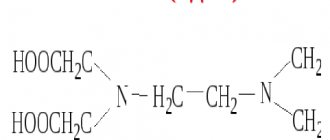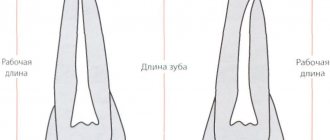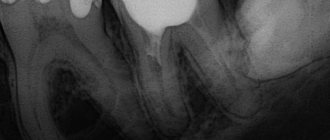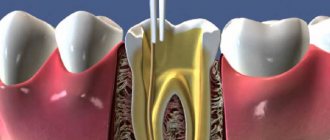Pulpitis and periodontitis: clinical picture of the development of caries and its complications
If we talk about the structure of a tooth in a simplified way, then it has a crown part that protrudes above the gum, and a root (or several roots) that hold the tooth in the bone tissue of the jaw.
Inside, under the enamel layer, the tooth is filled with dentin, in the thickness of which there is a small space. There are nerve endings and blood vessels that supply the tooth. They enter the root canal through the apex, fill it from the inside, and also occupy a small space in the crown of the tooth. The neurovascular bundle inside the tooth is the pulp. If you delay the treatment of caries, pathogenic microorganisms will begin to penetrate the pulp, causing its inflammation. This complication caused by caries is called pulpitis. With this disease, the pulp swells and puts pressure on the nerve. This is why the pain is so intense. The difficulty of pulpitis in root canal treatment sometimes lies in the fact that the teeth are connected by nerve endings and it can be difficult to immediately determine which of them is causing the pain.
When the pain does not go away, and also intensifies at night, this indicates that the inflammation has gone further - into the root canals of the tooth. If you do not treat the tooth canals during pulpitis, and try to drown out the pain with medications, then the infection from the root canals will spread to the bone tissue of the jaw.
The inflammatory process that begins in the bone around the apex of the root is called periodontitis. Treatment of canals for periodontitis and elimination of bone inflammation itself is much more difficult. Here you absolutely cannot delay contacting a specialist, otherwise the inflammation will quickly spread and intensify. Or it will become chronic, in which the infected area of the bone is replaced by granulomatous tissue or granuloma. As a result, the tooth most likely cannot be saved. This process is very dangerous: you can not only lose a tooth, but also provoke serious health problems.
Deep caries is a potential pulpitis, followed by periodontitis. A simple examination 1-2 times a year will preserve the health and beauty of your teeth, nerves and money. Since canal treatment for pulpitis and periodontitis is not the easiest, and also not cheap. In addition, there is a high risk of complications and tooth extraction in advanced cases.
Periodontitis: treatment, stages. What is dangerous about dental periodontitis - treatment of advanced forms of the disease
Thus, if you have persistent, intensifying aching pains that have a clear localization, rush to the dentist.
The sooner treatment begins, the easier it can be.
For dental periodontitis, treatment necessarily performs the following tasks:
- removal of decaying pulp tissue from the canals;
- antibacterial treatment;
- eliminating inflammation in the periodontium and stimulating its recovery;
- tooth preservation.
If necessary, antibiotics are used. With purulent periodontitis, treatment and cleaning stages are more complex than with acute periodontitis. In general, treatment is carried out according to the following algorithm:
- first visit – diagnosis and development of a treatment plan;
- administration of anesthetic;
- opening and treating a tooth cavity affected by caries, opening access to the canals;
- cleaning canals from decaying pulp;
- mechanical treatment of canals with tools for convenient filling;
- placing medicine and insulating material in the canal;
- installation of a temporary filling.
If there are no complications, at the next visit the dentist will restore the tooth crown using a permanent filling. This is the final stage of treatment. Gutta-percha is used as a material for filling canals for this disease in modern dentistry. This material fills the canal as tightly as possible, penetrating into all root branches, and does not have any toxic effects on the body. Treatment may vary in each case. For example, the presence of a fistulous tract in a single-canal tooth allows it to be cured in one visit. The presence of a cyst in the gum may require surgical intervention.
Our clinic provides all types of treatment for this and other diseases at an affordable price. Years of practice in various areas of dentistry allow us to perform work quickly and efficiently. We perform whitening, install permanent and removable dentures, and advise patients on proper hygiene and prevention of dental diseases. We can do everything! Contact us.
Root canal treatment
Before you begin root canal treatment, you need to take a photo. The fact is that in order to draw up an effective treatment regimen, the doctor needs to see the individual clinical picture of the disease: how deep the infection has spread and whether changes have begun in the bone tissue, how many roots the tooth has, perhaps the canals are too narrow and/or sclerotic. During treatment, it will be necessary to take more pictures to ensure the quality of the work done and the density of filling the canals with filling material. Only after making sure that everything is done correctly and efficiently will the doctor perform the final manipulations and restoration of the crown.
Treatment of root canal pulpitis
If no pathological changes in the bone tissue near the apexes of the roots are detected, then the canal treatment is performed according to the traditional scheme:
- Anesthesia with modern anesthetics. The drug is selected individually for each patient.
- Using a bur, the dentist removes tissue decay and opens the entrance to the pulp chamber.
- Then he needs to find the entrances to the channels, which is not always easy.
- Using special instruments and medications, the doctor removes the pulp from them, washes them, disinfects them from infection and dries them.
- The canals must be hermetically filled to the full depth with special filling materials - gutta-percha and polymer cement.
- Immediately after filling the canal, you must wait several days. Therefore, first the doctor places a temporary filling, and at a second visit he will restore the anatomical shape of the tooth with a modern photopolymer filling. Restoring the crown of a tooth after root canal treatment is a responsible task, the correct execution of which determines the reliability of the restoration and its service life. Often, the tooth is additionally strengthened with a pin, fixing it in the root canal.
Treatment of canals for periodontitis
It is not always possible to save a tooth if periodontitis has already developed. But with timely seeking help and proper treatment, the chances of a favorable outcome are quite high.
First of all, it is necessary to ensure the outflow of purulent mass from the inflamed area. Only after its elimination can treatment and filling of the root canals of the tooth be performed. Thanks to modern antiseptic drugs, it is possible to completely eliminate the infection from the affected area. However, in cases where the canal is too narrow to ensure the outflow of pus, it is not possible to save the tooth - it is immediately removed.
After the first stage of treatment, the patient is also given a temporary filling, with which he remains for about a week. You may need to undergo a course of antibiotic therapy. At the follow-up appointment, a thorough diagnosis is carried out. If no complications are identified, then the doctor installs a permanent filling and restores the tooth. Or prescribes further treatment based on diagnostic indications.
Stages of treatment of pulpitis of a single-canal tooth
Treatment of single-channel pulpitis is carried out in a shorter time than the elimination of tooth disease with two or more canals. The number of visits to the dentist is determined separately for each patient and depends on the degree of advanced disease. Stages of pulpitis treatment:
- Carrying out diagnostic activities. The doctor studies x-rays, interviews and examines the patient. Based on the information collected, the dentist makes a diagnosis.
- Anesthesia. Treatment is carried out under local anesthesia. The doctor administers painkillers to the patient. This helps prevent pain during procedures.
- Removal of tooth tissue damaged by caries. The dentist uses a drill with specialized attachments. All damaged tooth tissue must be removed. This is necessary to prevent relapse.
- Rinsing the cavity with a specialized solution.
- Removing pulp from the canal. The dentist uses a thin metal rod with spikes located along a helical line - a pulp extractor. The doctor selects the thickness of the instrument based on the individual characteristics of each tooth. To avoid relapse, the specialist completely removes the damaged pulp.
- Channel expansion. Cone-shaped instruments are used.
- Rinsing the canal and the entire tooth with an antimicrobial composition. After washing, the canal is dried.
- Installation of a seal. If treatment is necessary, the dentist puts medications into the canal and installs a temporary filling. It prevents food and bacteria from entering the tooth cavity. After a certain period of time, the dentist removes the temporary filling and installs a permanent one.
- Filling. The specialist fills the canal and the crown of the tooth.
- After the work is completed, the patient is sent for an x-ray. The dentist needs the image to monitor the correctness of the filling. The channel must be completely filled and contain no voids.
If the neurovascular bundle cannot be removed, the dentist places a specialized paste into the tooth cavity. It is necessary to kill the dental nerve. The cavity is sealed with a temporary filling. After a certain period of time has passed, the doctor will remove the temporary filling, remove the pulp and seal the tooth.
In some cases, the crown and canals are filled in two visits to the dentist. This ensures good fixation of the filling material. The dentist can monitor the reaction of a particular patient's body to the intervention. To prevent the entry of food and pathogenic bacteria, the tooth cavity is sealed with a temporary filling.
“Clinic of Your Dentist”: root canal treatment with care for each patient
The prognosis for the quality of treatment of tooth root canals for pulpitis and periodontitis directly depends on their structure and the degree of development of the disease. Treatment of dental canals in complex cases especially requires good equipment, high-quality medicines and materials, as well as extensive practical experience from the doctor.
“Clinic of Your Dentist” fully meets even the most stringent requirements for the quality of services and the professionalism of its specialists. Conducting effective root canal treatment and saving the patient’s tooth is our main task, which we successfully cope with!
Features of the structure of teeth, their roots and canals
There are no two identical root dental systems, which is explained by the purely individual structure of a person’s teeth. In addition, the root system of incisors, canines and molars is arranged in accordance with their purpose:
- Ones and twos (incisors) are needed for biting food.
- Fours and fives (premolars) perform the initial chewing function.
- Sixes and sevens completely grind food.
Based on this, it becomes clear that the seventh tooth requires more nutrients than the fifth. It must be strong and hardy, therefore it has a more developed channel system. Despite the fact that the 6th tooth in the lower jaw performs the same functions as the seventh, it usually has fewer canals. This is due to the fact that there is less chewing load on it.
For a detailed study of the structure of the dentofacial apparatus of a particular patient, radiographic examination is used.
Tooth structure
Each dental unit consists of:
- crowns - the area above the gum;
- neck - the area between the crown and the root;
- root - the area under the gum.
Inside the crown is the pulp, which passes into the root canals. At the end of the root there is a small apical opening through which blood vessels and nerve endings pass, starting from the main neurovascular bundle and ending in the pulp.
When a person’s pulp becomes inflamed, not only it, but also all root canals need to be cleaned of infected tissues, since they are “communicating vessels.” If even one canal is left uncleaned, pathogenic microorganisms will continue to develop inside the dental unit, which will lead to its removal. That is why the doctor must know the exact number of canals in the tooth.
How many nerves are there in a human tooth?
Thanks to the nerve, the tooth can respond to external stimuli. After removing the pulp and filling the canals, the dental unit loses sensitivity, as it is deprived of a nerve. But due to the removal of blood vessels, problems begin with its blood supply and mineralization. The crown becomes less durable and more prone to various chips and breaks. The enamel quickly darkens, and it cannot be properly bleached even with strong chemicals.
Before removing the pulp, the patient is sent for an x-ray to find out how many canals are in the operated tooth: a person has only one dental nerve in a tooth, but there may be several canals . This preparation allows for depulpation to be carried out competently and quickly.
Types of Root Canals
There are several options for the structure of dental canals:
- in the root there is one canal passage, which corresponds to one apical foramen;
- in the root there are several canal branches that connect in the area of a single apical foramen;
- two different branched passages have one mouth and two apical openings;
- canal cavities in one root merge and diverge several times;
- three root canal passages emerge from the same orifice, but have 3 different apical openings.
There can be as many channels as there are roots, but often their number differs. Several types of canals may be present in one molar and premolar.
How many canals in a person’s teeth - table
According to statistics, the number of canals depends on the depth of the tooth : the deeper it is located in the jaw, the more canals it has. This is due to the increased load on the molars located at the base of the dentition.
Typically, teeth in the upper jaw have more canals. But this pattern is not observed in all patients.
The table below presents average statistical data on how many canals are in a person’s teeth above and below.
| Dental unit | Number of channel passages | |||
| Fangs | Upper | 1 | ||
| Lower | 2 | |||
| Incisors | Upper | 1 | ||
| Lower | Central | in most cases 1, less often 2 | ||
| Lateral | 1 or 2 (about the same probability) | |||
| Premolars | Upper | First | most often 2, but sometimes first premolars with 1 or 3 canals are found | |
| Second | in most cases 2, sometimes 1 or 3 | |||
| Lower | First | 1 or 2 | ||
| Second | 1 | |||
| Molars | Upper | First | 3 or 4 with equal probability | |
| Second | in most cases 3, sometimes 4 | |||
| Third | around 5 | |||
| Lower | First | most often 3, sometimes 2 or 4 | ||
| Second | usually 3, but there are roots with 4 channels | |||
| Third | no more than 3 | |||
Number of canals in teeth in the lower jaw
The teeth on the lower and upper jaws are significantly different from each other. This is partly due to the uneven load and different functions. Typically, teeth in the lower jaw have fewer canals. But each specific case requires detailed study. Therefore, the dentist first sends the patient for an x-ray, and only then proceeds to open the crown and treat pulpitis.
It is impossible to start treating caries and pulpitis based only on encyclopedic information, because:
- The 6th tooth of the lower jaw can have any number of canals - from 2 to 4;
- in the 5th tooth below there is usually only 1 canal, but in approximately 10% of patients there are quints with 2 canals;
- In the 4th tooth there is usually only 1 canal, but in about a third of cases there are 2.
The eighth tooth on the lower jaw is the most “unpredictable”. Exactly how many canals are in the wisdom tooth located below can only be determined using x-rays. Officially, there are no more than 3 of them, but during the treatment of caries, additional cavities usually open. It is precisely because of its incomprehensible structure and inconvenient location that the figure eight is most often removed.
It is impossible to treat a dental unit without studying the structure of its root and canal system. This can only aggravate the pathology and lead to complications.
Number of canals in teeth in the upper jaw
The root system of the teeth of the upper jaw is more complex and branched. This explains the longer treatment of upper molars and the frequency of repeat visits due to incompletely sanitized dental cavities.
Features in the structure of the canal system of teeth in the upper jaw:
- The 6th tooth of the upper jaw is most often three-channel. But sometimes there are also four-channel first molars.
- The fourth and fifth teeth from above are most often two-canal, but sometimes single-canal and three-canal premolars are found.
- The 4th upper tooth usually has 2 canals, but sometimes there are premolars with 1 or 3 canals.
The “wise” eight on the upper jaw is a four-channel tooth. Third molars with 5 canals are extremely rare. However, in dentistry, even cases of the presence of eight-channel wisdom teeth located at the top have been recorded.
Why do we need a channel in the first place?
A canal is an anatomical space within a tooth root. They act as a continuation of the pulp chambers, each of which represents a single tooth cavity and duplicates the contours of dental crowns in shape. Healthy canals contain nerves and blood vessels that are responsible for metabolism. Each canal begins as an orifice at the neck of the tooth and ends with an apical foramen at a distance from the central apex of the root.
After removal of the nerves (in case of complicated caries, infection), the canal openings are filled with special pins and fillers. Teeth deprived of nutrition darken.
The length of the canals of the teeth of the upper and lower jaw
To carry out high-quality endodontic treatment, it is important to know the length of the dental canal. The length of the tooth canals (the table below) depends on the size of the tooth itself. Determining such parameters is possible in several ways.
The initial preliminary assessment is carried out in a tabular manner (average canal length and its variability in mm depending on the tooth formula):
| Tooth formula | Upper jaw, mm | Lower jaw, mm |
| 1 | 13,0 +/- 1,7 | 12,8 +/- 1,6 |
| 2 | 12,9 +/- 1,6 | 13,7 +/- 1,6 |
| 3 | 15,9 +/- 2,4 | 15,3 +/- 2,1 |
| 4 | 13,6 +/- 1,8 | 13,7 +/- 1,7 |
| 5 | 14,4 +/- 1,9 | 15,2 +/- 1,8 |
| 6 | 13,3 +/- 1,7 | 14,5 +/- 1,7 |
| 7 | 13,0 +/- 1,8 | 14,1 +/- 1,7 |
| 8 | 12,2 +/- 2,0 | 12,8 +/- 1,9 |
Sometimes the length of the tooth canals can be determined from an x-ray, but the x-ray image in most cases does not reflect the true size.
With an accuracy of 60-97%, the length is determined electrometrically (by changes in the electrical resistance of tissues) using an apex locator.
The tactile method is based on slowly immersing the probe into the canal until it jams.
According to the patient’s sensations (a slight “prick” when moving the instrument past the root apex), during treatment without anesthesia, the length of the canal is also determined approximately.
Using a combination of several approaches is effective.
Tooth root: structure, length, purpose
The root of each tooth is located in its own alveolar cavity, hidden by the gum. It (like a tooth) consists of dentin, covered on the outside with cement - bone tissue that comes into contact with the enamel next to the dental neck. The entire structure, together with the connective fibers, forms a shell between the alveolus and cement (periodontium).
Depending on the location, the root can be single or branched. Normally, the maximum number of root cavities is 4. Their length depends on the size of the tooth; it necessarily reaches the bundle of vessels and nerves of the alveoli, from where the unit receives nutrients. It is determined using an apexlorator probe, which is immersed in the hole until it jams.
The main function of the root is to secure the tooth in the gum, for which a strong ligamentous apparatus is provided. Its channels provide access to the nerves, arteries and veins to the coronal part. Thanks to this, the tooth receives nutrition, develops, and is sensitive to external influences. Due to innervation, the tooth is a full-fledged organ located in the oral cavity.








